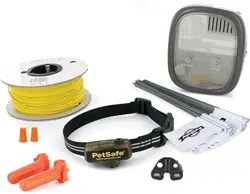Loading ...
Loading ...
Loading ...

24 www.petsafe.net
ENFRES
NL
IT
DE
8. Note the original position of the Boundary Width Control knob and turn the Boundary Width control knob to 10 and then
back to 5.
9. Place the Test Light Tool Contacts on the Contact Points of the Receiver Collar. While holding the Receiver Collar with the
Test Light Tool in place, start outside of the test loop and walk toward the loop. Make a mental note of the distance between
you and the wire when the Receiver Collar activates.
10. Turn the Boundary Width Control knob to 10 and repeat Step 9. The distance where the Receiver Collar activates should be
greater than that of Step 9.
11. If more than one Receiver Collar is used on the system, repeat the above test on each collar.
12. Interpreting the Results:
a. If the Power light or the Loop indicator light are not both lit on the Fence transmitter, or the alarm is on, there is a problem
with the transmitter. Contact the Customer Care Centre. (Australia and New Zealand only: Check and replace the Fence
Transmitter fuse if necessary. If replacing the fuse does not correct the problem, there is a problem with the transmitter.
Contact the Customer Care Centre.)
b. If both the Power and Loop indicator lights are on, but the Receiver Collar does not activate on the test loop wire, the
Receiver Collar is not working. Contact the Customer Care Centre.
c. If both the Power and Loop indicator lights are on and the Receiver Collar is activating at different distances on the test
loop wire, the problem is in the containment Boundary Wire .
13. If both the Power and Loop indicator lights are on and the Receiver Collar is activating at different distances on the test loop
wire, the problem is in the containment Boundary Wire. Perform the Wire Break Location Test.
14. When testing is complete, return the Boundary Control Switch and the Boundary Width Control setting to their
original position.
15. Repeat the Boundary Width testing from Step 6 on Page 13 until you achieve the desired Boundary Width between
3.7 m and 6.1 m (12 ft and 20 ft).
Transmitter Loop Test
The Transmitter Loop Test is a simple test to determine the cause of a “Boundary Wire Broken or Disconnected” alarm indication.
You will need a short 3 metre (10 foot) piece of Boundary Wire with 1cm (3⁄8") of insulation stripped from both ends.
The receiver collar should not be on your dog when the system is tested. Your pet
may receive an unintended stimulation.
Verify the transmitter is plugged into the AC power outlet and all Boundary Wire connections at the transmitter are
properly connected. If the transmitter Power light is on, the Loop indicator light is off, and the alarm is on, continue with the
following steps:
1. Remove the twisted wire from the Fence Transmitter Boundary Loop terminals by pushing the red release levers on the
connector and pulling the wires free.
2. Insert both ends of the 3 m (10 ft) wire loop into the Boundary Loop Terminals and recheck the transmitter Loop indicator light
and alarm.
a. If the Loop indicator light is green and the alarm is off, there is a problem with the Boundary Wire. Check for visible
damage to the wire at the entry into the house. If none is observed, perform the Wire Break Location Test to nd and
correct the wire break in your Boundary Loop.
b. If the Loop indicator light is still off and the alarm is on, there is a problem with the Fence Transmitter.
3. Contact the Customer Care Centre for assistance.
Wire Break Location Test
Please follow these steps in determining where you have a break in your Boundary Wire:
1. Locate your original splice(s) and verify they have a good, solid connection.
Loading ...
Loading ...
Loading ...
